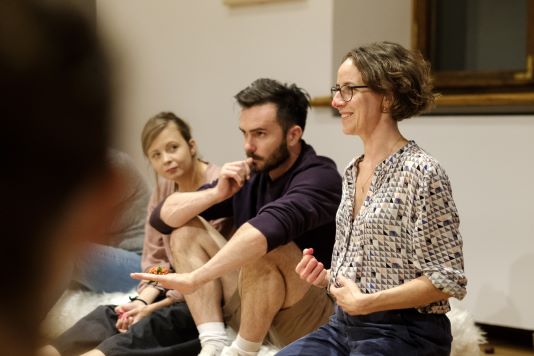Marysia (Maria) Stokłosa
Self-care as Resilience
Before sitting down to write, I discussed this theme with a Contact Improvisation teacher and a friend of mine who showed me this short YouTube-video: (The dark side of) RESILIENCE by Embodied Ethics (https://www.youtube.com/watch?v=RLN13A8YNwc). While “resilience” is seen as a very important trait in the video, the YouTuber “Embodied Ethics” also talks about the danger of entertaining difficult situations for too long, rather than moving forward. For her, this is the dark side of resilience which eventually leads to burn-out and sickness. Encouraged by the video, I have decided to share my personal story with you.
As someone in the experimental dance scene, I have continually been exposed to very high-pressure situations. Making a living, applying for funding for dance productions as well as the need for networking around curatorial interests, which are critical in shaping the dance industry – all these aspects have challenged me greatly. Living on the edge of the cultural scene without state support or a regular income required me to develop many coping strategies, often understood as resilience. Everyone I knew in the field, including myself, was engaged in many different projects to gain some sense of security. The tiredness by endlessly producing whilst running out of money is a very common feeling among creatives. Successful in shaping a professional career, however drained of energy by the working conditions, I finished my last production at the end of 2018. In The Queen of Water (See images of the production here: https://u-jazdowski.pl/en/programme/exhibitions/inne-tance/marysia-stoklosa) we meditated with the audience for a few minutes and then went on a silent walk through Warsaw in the dark to channel our vision for change – both in the art scene in Poland, as well as across the world.
Working with body, movement and somatic methods, I was able to practice different methods for reducing my own stress. However, by the end of 2018 I had suffered from extreme physical and mental exhaustion. I had to stop and reconsider my life. Luckily for me, my family were able to financially support me, so that I could afford to not take on as much work and set priorities for other things. I left my boyfriend, began therapy, sold my apartment and moved to a quieter part of the city. I enrolled in the Cultural Studies programme at the University of Warsaw. I was still performing and teaching, but I was no longer saw the next production opportunity as a matter of life or death. I was now convinced that, at least by the end of this transformative phase in my life, an opportunity would arise where I could use my skills in a more sustainable work environment.
But then, the first wave of COVID hit Poland. In the first few months it took a hold of the country, and I went through a period of deep grieving. The social aspects of dance – dancing together, watching each other perform – had been postponed for an unknown length of time. Independent dance disappeared from the artistic landscape. Dancers and choreographers not employed in state theaters, were also bypassed by the financial compensations. Initially, I was engaged in protest activities for the dance community and I wrote several letters to the ministry of culture to bring attention to the problem. But the current political climate in Poland does not encourage dialogue on this topic. Eventually, I felt drained again. I couldn’t see any progress in our efforts and felt I had lost my place in the industry for good.
Distance teaching was possible, but sharing space with other moving bodies is very different. I did eventually find ways to support people by encouraging them to practice self-awareness, movement and creativity through online classes. I coped, and gradually I came to accept the situation. Isolation, working from home, taking care of my son was like living in a pressure cooker, and I soon had to reconsider my everyday life. Facing exhaustion again, I started to pay more attention to my wellbeing. I needed both discipline and self-care. I began to incorporate simple things into my daily routine, such as not bringing my phone into my bedroom, going to bed early and exercising daily. Prioritising time with close friends was an important part of my self-care. All of a sudden, I realized that by observing my own needs as artist, teacher, and parent, rather than trying to endure the situation, I am also able to provide more support to others. This challenging time helped me to realize that – from now on – self-care will be key to my art, teaching, and in my life in general.
My experience leads me to ask: Can resilience include learning how to care for ourselves in times of crisis? What if the new values and skills required for this can be put into practice after the pandemic? What if we cease trying to endure more than what is healthy for us and leave this “dark side of” resilience behind, instead taking the time needed to recharge our batteries? When I practice and teach dance and choreography, I focus on the potential of the body as a doorway to awareness of physical sensations, feelings, thoughts, or fantasies. By practicing awareness, I have learnt to listen to what my body needs, to recognise my interests and pleasures, and also notice mine and my peers’ limits.






